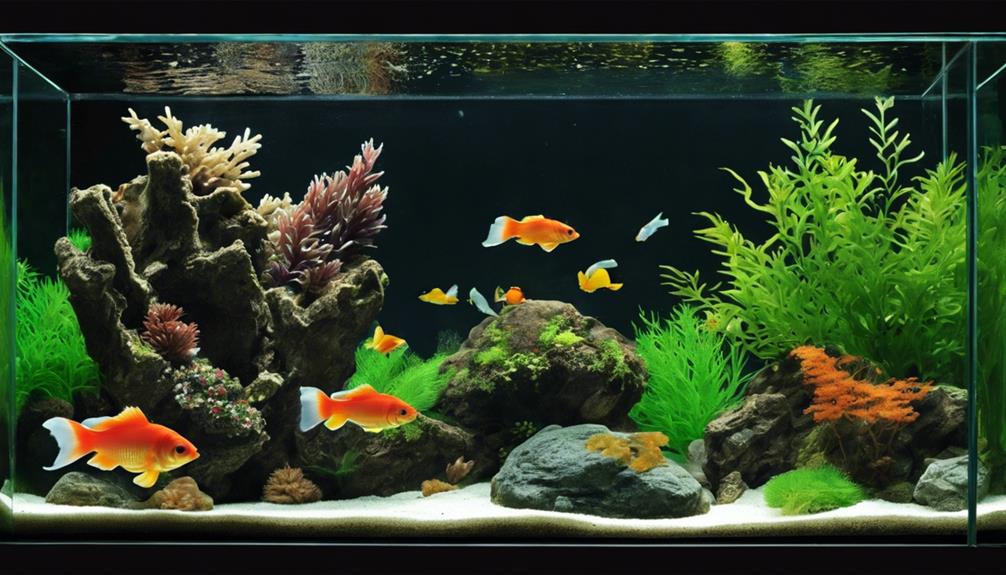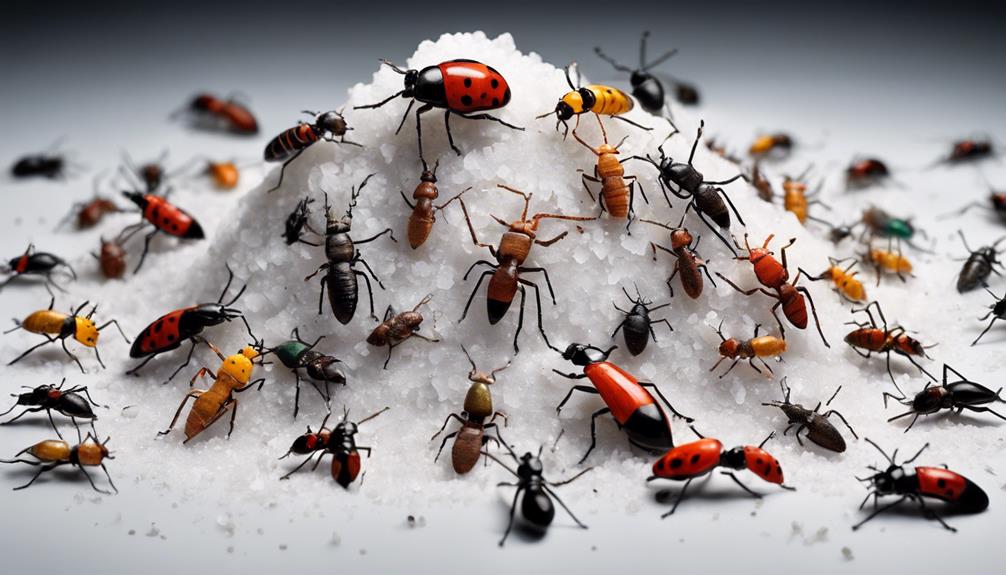When my fish stays in one spot, it might be due to water quality issues. Testing pH and harmful substances like ammonia is crucial. Check temperature and oxygen levels too. Illness signs include lethargy and appetite loss – consult a vet if needed. Oxygenate water with an air pump and airstone. Guarantee hiding spots and proper lighting for comfort. Clean filters regularly for clean water. Seek a vet's advice for diagnosis and treatment. A stress-free environment promotes fish health. Maintaining good water quality is key. Addressing these factors can help your fish thrive better.
Key Takeaways
- Check water parameters for issues causing stress.
- Ensure proper oxygen levels with air pumps or airstones.
- Create a stress-free environment with hiding spots.
- Monitor fish behavior closely for any changes.
- Seek guidance from a veterinarian for expert advice.
Assess Water Quality
Evaluating water quality is vital for maintaining healthy and thriving fish in your tank.
To make sure your fish are happy and active, it's essential to regularly test the pH levels, as well as monitor the levels of harmful substances like ammonia, nitrite, and nitrate. Fluctuations in these parameters can lead to stress in fish, affecting their behavior and potentially causing lethargy.
Additionally, keep an eye on the water temperature and oxygen levels, as these factors play a significant role in your fish's overall well-being.
Check for Signs of Illness
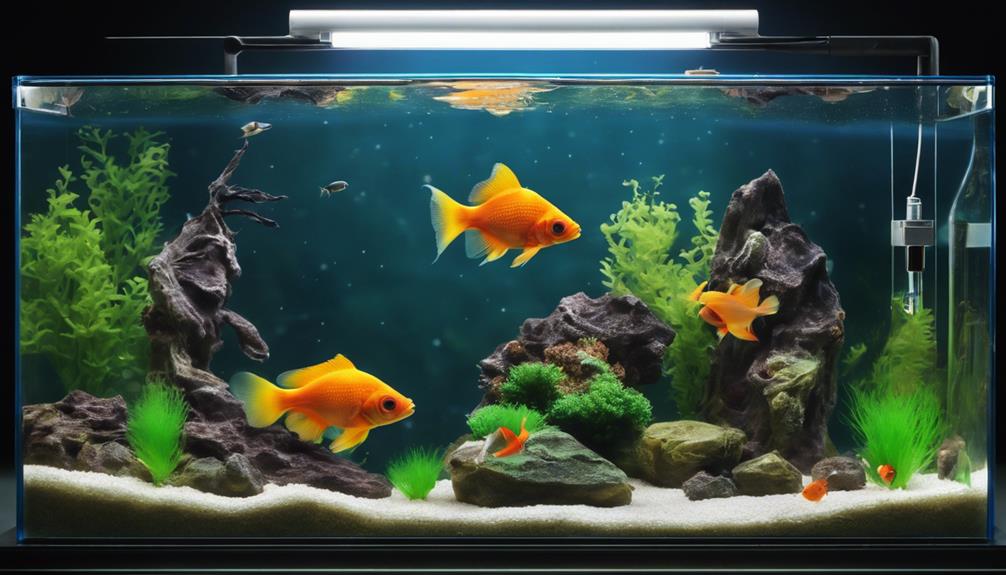
When observing your fish, it's important to monitor closely for any signs of illness that may indicate underlying health issues.
- Look for signs of illness like lethargy, loss of appetite, abnormal swimming patterns, or visible parasites on the fish.
- Check for physical symptoms such as discoloration, fin damage, lesions, or unusual growths on the fish.
- Monitor water parameters closely to guarantee ideal conditions for the fish's health and well-being.
- Consider consulting a veterinarian or experienced fish keeper for guidance on diagnosing and treating potential illnesses.
- Quarantine the affected fish to prevent the spread of disease and provide targeted treatment if necessary.
To safeguard your fish's well-being, it's essential to be vigilant about any changes in behavior or appearance. By promptly identifying symptoms of illness and taking appropriate action, such as quarantining affected fish and seeking professional advice, you can effectively manage the health of your aquatic pets.
Regular monitoring and swift treatment play a crucial role in preventing disease spread and maintaining a thriving aquatic environment.
Ensure Proper Oxygen Levels
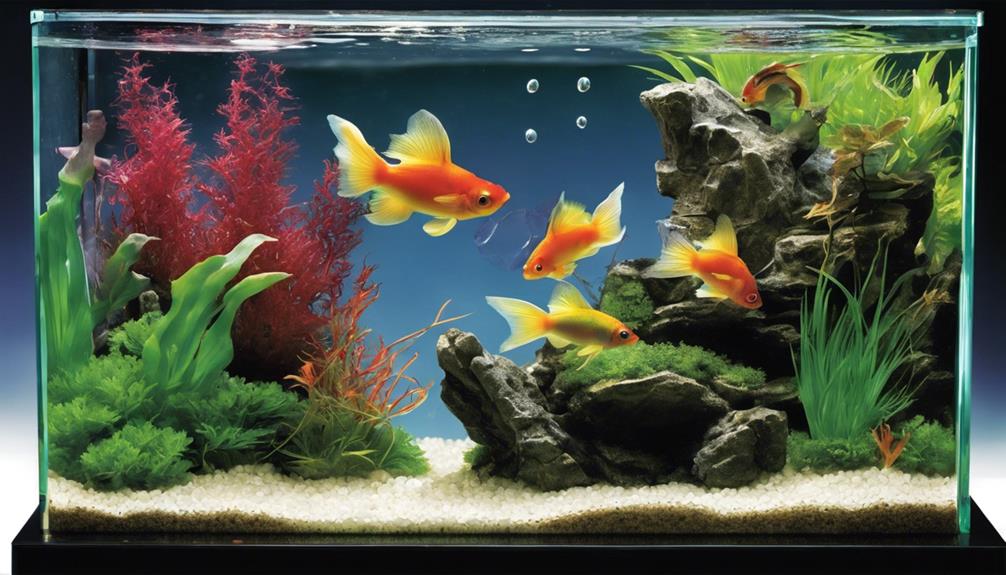
Alright, let's talk about ensuring proper oxygen levels for our fish friends. Monitoring the dissolved oxygen in their tank is super important because low levels can stress them out and make them sluggish.
To keep our underwater buddies happy and healthy, consider using aerators or oxygenating plants to boost the oxygen content in their environment.
Oxygenation for Fish
To maintain excellent health for fish in an aquarium, ensuring proper oxygen levels is paramount. Here are some innovative ways to oxygenate your fish tank effectively:
- Air Pump: Utilize an air pump to increase oxygen exchange in the water.
- Airstone: Attach an airstone to the air pump to create bubbles that enhance oxygenation.
- Surface Agitation: Promote oxygen absorption by creating surface agitation in the tank.
- Live Plants: Introduce live aquatic plants that release oxygen during photosynthesis.
- Test Kit: Regularly test oxygen levels using a reliable test kit to monitor and adjust as needed.
Monitoring Water Quality
Maintaining ideal oxygen levels in your aquarium is vital for ensuring the health and well-being of your fish. Monitoring dissolved oxygen levels is key to understanding the environment your fish are living in. Low oxygen levels can lead to stress, immobility, and even death in fish.
To address this, proper aeration using air pumps or oxygenating plants can help maintain oxygen levels. Factors like temperature, stocking density, and water circulation can affect oxygen levels, so regular water testing and adjustments are essential.
Provide Stress-Free Environment
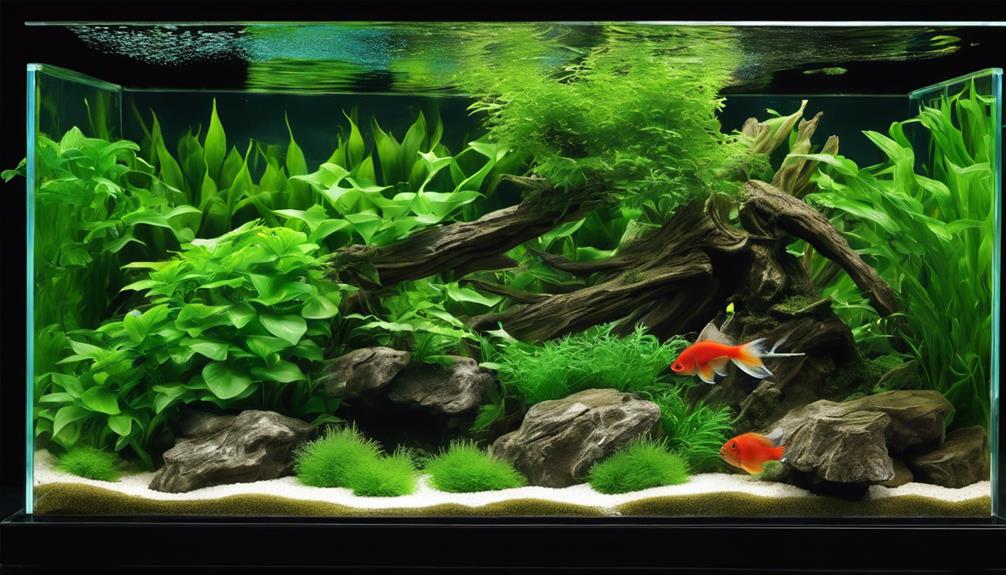
To provide a stress-free environment for your fish, make sure the tank decorations offer plenty of hiding spots for them to feel secure. Keeping the water parameters stable, such as temperature and pH, is essential in creating a calming atmosphere for your aquatic pets.
Additionally, monitoring the tank lighting to avoid excessive brightness can help prevent stress in fish.
Ideal Tank Conditions
Creating a stress-free environment in a fish tank involves ensuring stable water conditions, providing hiding places, and maintaining proper lighting and filtration. To keep your fish happy and active, consider the following tips:
- Monitor Water Parameters: Regularly check and adjust temperature and pH levels.
- Offer Hiding Spots: Create nooks with plants or decorations for a sense of security.
- Optimize Lighting: Ensure there are light and dark periods for natural rhythms.
- Maintain Filtration: Clean filters regularly to keep water clean and oxygenated.
- Observe Behavior: Watch your fish for cues on their preferences and adjust accordingly.
Enrichment Activities
Adding enrichment activities to a fish tank can greatly enhance the well-being of the fish and encourage natural behaviors. To create a stimulating environment, consider incorporating a variety of elements such as tank decorations, live plants, and hiding spots. Rotating toys and rearranging tank features periodically can keep your fish engaged and prevent boredom. Providing different feeding locations and food types encourages movement and exploration. Interactive toys and puzzles offer mental stimulation and physical activity, reducing the chances of your fish staying in one spot. By offering a range of enriching activities, you can promote a stress-free environment that supports your fish's overall health and happiness.
| Enrichment Activities | Benefits |
|---|---|
| Tank Decorations | Promote exploration |
| Live Plants | Create natural setting |
| Hiding Spots | Reduce stress levels |
Health Check-Up Routine
To guarantee the well-being of our fish and maintain a stress-free environment, establishing a regular health check-up routine is paramount.
- Conduct regular water tests to ensure top-notch water quality for fish health.
- Provide adequate hiding spots and shelter to reduce stress and promote natural behavior.
- Maintain stable water parameters like temperature and pH to create a stress-free environment.
- Monitor fish behavior closely for any signs of distress or illness.
- Implement a consistent feeding schedule to support fish health and well-being.
Monitor Fish Closely
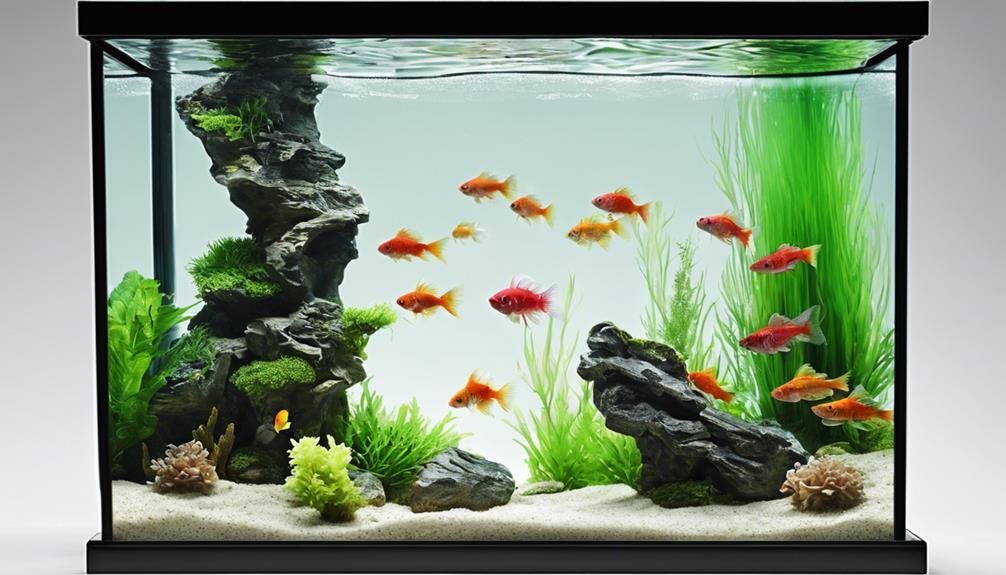
Keeping a close eye on the fish is vital to understanding the reasons behind their lack of movement. By monitoring fish behavior, signs of stress, illness, or environmental factors can be detected.
Observing water quality parameters like temperature, pH, and ammonia levels is essential in maintaining a healthy environment for your fish. Additionally, checking for physical injuries or abnormalities in the fish can provide insights into their immobility.
Regular fish tank observations are key to identifying any changes in behavior or appearance. If issues persist, seeking professional advice is recommended to address any underlying problems effectively.
Consult a Veterinarian

Consulting a veterinarian specializing in aquatic animals is essential when addressing fish that remain stationary in their tank. When seeking professional guidance for fish health and behavior, a veterinarian offers invaluable expertise in diagnosis and treatment options tailored to aquatic animals.
- Expert Diagnosis: Veterinarians can accurately diagnose underlying health issues contributing to the fish's abnormal behavior.
- Specialized Treatment Options: They can recommend specific treatment options designed to meet the unique needs of aquatic animals.
- Professional Guidance: Veterinarians provide essential guidance on the care and management of fish health concerns.
- Ensuring Well-being: Seeking veterinary assistance is vital for the well-being and recovery of fish exhibiting abnormal behavior.
- Comprehensive Care: Veterinarians offer holistic care to address not only the symptoms but also the root causes of fish health issues.
Maintain Good Water Quality Post-Treatment
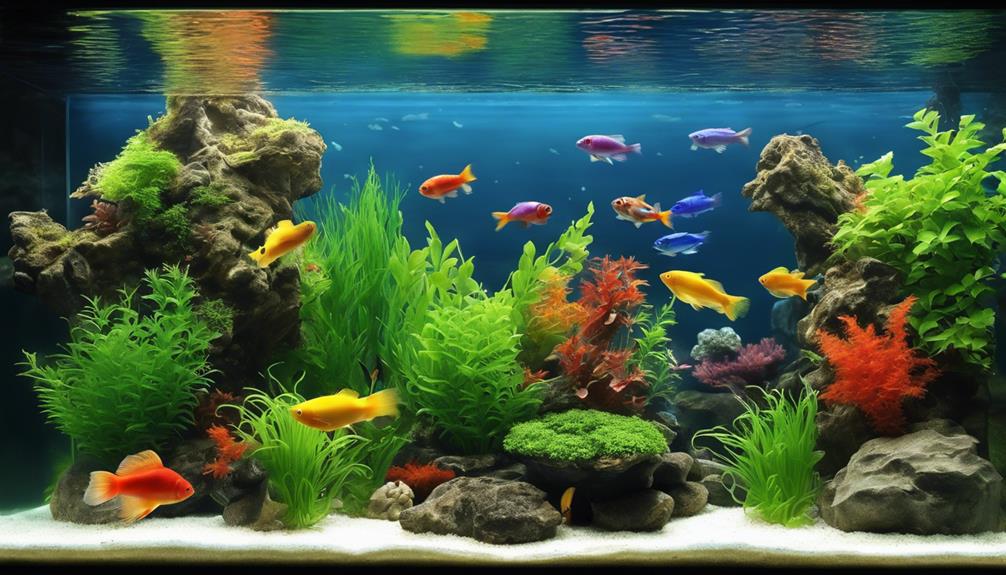
When addressing fish that remain stationary in their tank, it's important to guarantee that good water quality is maintained post-treatment. Monitor water parameters closely to make sure they're at levels best for fish health. Conduct regular water tests to track any changes that could affect the recovering fish.
Keep a close eye on fish behavior and appearance for any signs of relapse or new health issues. Providing a stress-free environment with ideal water conditions supports the fish's recovery process. Consulting with a fish veterinarian or expert for guidance on maintaining good water quality and post-treatment care is essential.
Frequently Asked Questions
Why Is My Fish Only Staying in One Spot?
Staying in one spot, fish may signal stress, water changes, or territorial behavior. Factors like lighting, water flow, and vibrations impact their behavior. Conduct head counts, check water quality, and eliminate stressors. Experiment with pump placement and water flow adjustments for improvement.
What to Do if Your Fish Don't Get Along?
If my fish don't get along, I introduce new hiding spots and territories to reduce aggression. I monitor behavior for stress signs like fin nipping. Separating aggressive fish or providing dividers prevents fighting. Each fish needs space to establish territory.
How Do You Save a Struggling Fish?
To save a struggling fish, closely monitor for distress, check water quality, isolate if needed, provide a stress-free environment, and seek advice from experts. By taking proactive steps, you can improve the fish's health and well-being.
How Do You Help a Stressed Fish?
To help a stressed fish, I monitor water parameters, provide hiding spots, maintain stability in the tank, feed consistently, and consider peaceful tank mates. These strategies create a secure environment and promote well-being in my fish.
Conclusion
To sum up, dealing with your fish remaining in one spot involves:
- Evaluating water quality
- Inspecting for signs of illness
- Guaranteeing proper oxygen levels
- Offering a stress-free environment
- Keeping a close eye on your fish
- Seeking advice from a veterinarian
- Upholding good water quality post-treatment
By following these steps, you can help your fish stay healthy and content in their tank.
Remember, a content fish is a healthy fish!
